How to Improve Net Promoter Score: The Complete Guide

Last updated on February 16, 2024
In this article you will learn everything there is to know about the Net Promoter Score. We will explain the basics of NPS and share best practices for how to collect, analyze, and use your NPS results.
How do you make important or day-to-day consumer decisions in your life? Whom would you consult if you were choosing a hairdresser’s salon or a new car to buy?
83% of customers would trust recommendations from the people they know: colleagues, family, friends, etc. Often, we believe that people close to us can give us better advice when choosing a product or service.
According to the same research, at least 66% of customers trust other consumer opinions posted online and according to another research, 58% of consumers said they have recently (within the past five years) been leaving more and more online reviews based upon customer service.
That proves that referral marketing plays a more and more important role in business strategy.
The question is, how can you measure it?
The Net Promoter Score: what is it?
The Net Promoter Score (or NPS) was designed by Fred Reichheld in 2003 to measure loyalty. At that time customer experience management was still unknown to most businesses.
Gradually NPS gained popularity and was implemented everywhere: from customer service interactions to every individual customer touchpoint. People have been obsessed with “the only number you need to know” since it was developed, and according to our net promoter score statistics research, around 64% of companies use NPS to measure the customer experience. This is not a surprise, because NPS gives a very simple and easy-to-track system to allow you to follow your most and least loyal customers.
It is likely that you have already seen it on a regular basis:
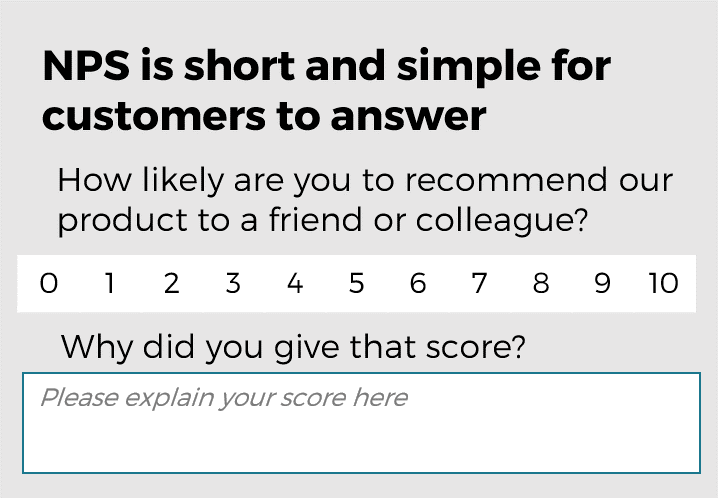
NPS consists of two questions: a scoring system (typically asked with “How likely are you to recommend (brand) to a friend or colleague?“) and the “why” question. The scoring system divides all respondents into 3 groups:
- Promoters (answered 9-10): typically loyal and enthusiastic customers likely to recommend you
-
Passives (answered 7-8): currently satisfied but easily tempted by your competition
- Detractors (answered 0-6): unhappy customers, a high likelihood of negative word of mouth, a high churn rate
“Promoters are significantly more loyal, so most businesses would do well to create promoters and decrease detractors.”
— Bruce Temkin
You can calculate the Net Promoter Score by identifying the difference between the percentage of promoters and the percentage of detractors. For example, if 65% of your customers are promoters and 12% are detractors, NPS is 53.
Note: NPS can also be negative if the percentage of detractors is higher.
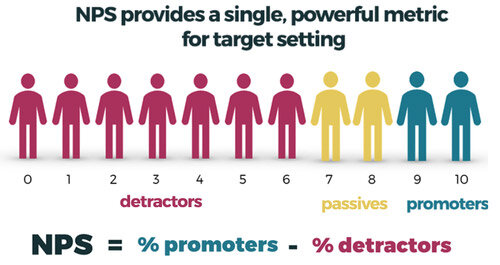
Many companies are focused on following NPS as a number. It’s no surprise that they do, as according to this research of the London School of Economics an average NPS increase of 7% correlates on average with a 1% growth in revenue. Isn’t that a solid reason to think about how to increase your NPS?
⛔️ Don’t fall into this trap.
If your company focuses on following the score only, you will very happy if the NPS goes up. But what will you do if the score starts to fall? Many companies panic: customer research is commissioned, task forces established, and people start to read the feedback just to understand what is going on.
Keep in mind that NPS only becomes a truly valuable metric, if its “why” question is properly collected, analyzed and heard.
The “why” question is the golden source for your customer experience management. It shows you why a customer gave this or that score, opens up a dialogue, and, in a way, lets you dive into your customer’s head.
“NPS has been a good metric to benchmark and help brands understand the overall outcome of their experience. The real value is in the “WHY”. A lot of companies will chase the score but customer-centered companies will dive into the “why” to discover what is creating the experience and move to action to circle back to the customer or design new experiences. Here NPS becomes less about the score and actually about the experience.”
– Diane Magers, CEO of CXPA
To summarise, NPS can be very efficient as it provides both a quantitative metric to set targets against and follow, and also free text feedback for insight generation. At the same time, an NPS survey is simple and short enough for consumers to respond to regularly.
How to collect NPS: Best Practices
Here we’ve collected the best practices, tips, and most common problems our customers come across when implementing and, later, using NPS.
1. First things first: Get that wording right!
The more popular NPS got, the more misused the metric became. The Net Promoter System is an open source system, which means you can change and customize the questions for your own purpose. Unfortunately, this sometimes leads to a misunderstanding of customer feedback, and the voice of the customer can be ignored as a whole.
“How likely are you to recommend (brand/product name) to a friend or colleague?”
Net Promoter Score allows you to switch between your “brand” to “product”, if that follows the reason for your survey. If you ask about your brand, you will receive measurements of brand loyalty, and if you ask about a particular product or service, you should receive more product-specific feedback.
NPS doesn’t tie you to “a friend or colleague” wording. You can easily reference any individual or role that is suitable for your business. The options include “a family member”, “a manager” or “a classmate.”
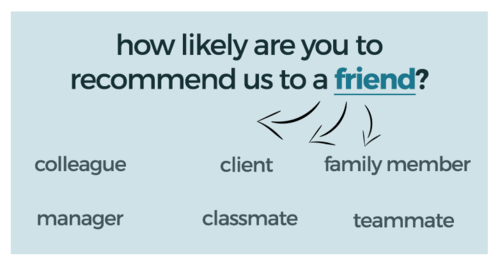
“Why did you give that score?”
The “why” question that brings you closer to understanding your promoters, detractors, and passives is sometimes changed to “tell us how we can improve” or “let us know what you liked most about us“. We do not recommend this change as it leaves out all the negative reasoning, and brings you further away from understanding the real Voice of Customer.
The scaling system
Last, but not least, some of our customers asked us if they could change the response scale to 1-5, 0-7, etc. Is there a reason to do so? If you change the response scale, all the analysis and published literature would still be based on the 0-10 scale. You may lose some of the value of your data. For more than 10 years, the 0-10 scale has been proven to work.
In the end, however, the one thing that matters most is consistency.
If you insist on changing the wording or scaling system of NPS, please do that with all your NPS activities. Don’t mix different types of questions or scaling systems, as it’s not only hard to compare, but also costs much more to maintain.
2. How to collect NPS
Collecting Net Promoter Score in the right way ensures that you reach your goals. It can also nicely increase your response rates if you know when and where you need to ask for feedback. That being said, let’s think about…
When to ask for feedback?
Many companies often start measuring NPS at the one touchpoint (which is often customer service, as it is the most obvious option) that they think is the most important. Then they fix the issues for that touchpoint and sometimes wonder why it doesn’t bring any results or brings results different from what they expected.
In order to avoid this mistake, the first must-do is to measure the holistic experience of your customers. Don’t go into measuring the success of your customer service or any other touchpoint before you have actually identified what your customers love and hate about your products or services overall. You can then use that data as a starting point when deciding what areas you need to focus on for improvement.
Identify the best time to get feedback on the overall experience and relationship. This could be a month after onboarding, and then annually or bi-annually at the onboarding anniversary for example.
Once you have your baseline of customer feedback, you can then ask about the most critical touchpoints identified, requesting very specific feedback (e.g. about your new mobile app, your website, customer service interactions).
NPS should be part of your ongoing customer experience management process where you collect feedback, analyze it and use the insights to help you make decisions and improvements so you can close the loop with your customers.
Where to ask for feedback?
The answer to the question “Where should I ask for feedback from my customers?” largely depends on what you want to track with the feedback. Do you want to measure the overall experience? Do you want to measure the performance of one particular touchpoint? Do you want to measure the performance of an app, a product, or the brand reputation of the whole company?
Here are some ideas you could use:

The general rule is to always use the most natural channel available to ask for feedback from your customers. If you want to measure how satisfied your customers are with your app, it makes sense to ask for feedback in the app itself.
3. How to analyze Net Promoter Score feedback
Don’t end your feedback analysis by calculating the score. Understanding why your customers are happy or unhappy is the main reason you should ask for feedback in the first place.
We know that analyzing tens of thousands of individual feedback comments can be tiring, inefficient, and costly from a resource perspective. That’s where NPS software platforms and text analytics come into play.
Simple sentiment analysis of the text can divide a feedback comment into three buckets: positive, neutral or negative. Machine learning technologies can detect the degree of sentiment as well: if someone hates your product, the negative sentiment is stronger than if he or she just dislikes it. Similarly, if someone loves your customer service personnel, the positive sentiment is stronger than if they simply like them.
Let’s take a look at this comment:
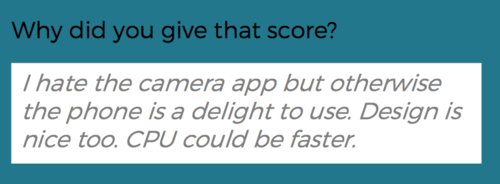
The machine would likely give you the following results:
Topic Sentiment
Camera software Strongly negative
Product general Strongly positive
Performance Somewhat negative
Design Somewhat positive
These results give you a better understanding of what the user was saying, and together with the other thousands of comments, the data becomes more significant so that you could use it in your product and business development in the future.
That’s just one example of how the why question of NPS helps you to understand the reasons behind the score.
Here are a couple of our findings when it comes to text feedback:
- Customers typically mention the most important things on their minds in the feedback.
- Free text form is great in surfacing topics that matter most to consumers – asking about all topics using closed questions would require an extremely lengthy questionnaire which can result in lower response rates.
- Free text analysis typically includes categorizing the feedback to better understand which topics are talked about and assessing the sentiment of the sentences. This basic analysis can then be expanded on e.g. by calculating the impact of each topic on the NPS.
Recommended reading:
15 Tips on how to send NPS email surveys you can implement right away
7 Ways to increase response rates on your NPS surveys
7 Most common Net Promoter Score mistakes and how to avoid them
Learn from the best, or NPS case studies
Often businesses pose the question: “How can we improve NPS?“. That is the wrong question. What those businesses often forget is that a higher NPS won’t necessarily bring you any business results if you don’t understand or act on your customer feedback.
We asked Diane Magers, CEO of CXPA, how to tie NPS and customer experience to business value:
“You can correlate NPS to better business results such as revenue and retention. Focusing on customer behavior and measures can help you tell a more detailed business story. Here’s one example: imagine that you want your customers to go online and self-serve instead of going to the call center. Here you could measure the number of people who self-serve vs. call in and it has value. The online interaction might cost you 10 cents and a call might cost you 12 dollars (in the US). In this case, the better online experience is tied to the business value.“
In addition, the NPS segments: promoters, passives, and detractors, can quite accurately predict how these customers will maintain their relationships with the brand. To analyze the connection between loyalty and the Net Promoter Score, the Temkin Group conducted the research “Economics of the Net Promoter Score” in 2016.

According to the research, promoters are more than five times as likely to repurchase from companies, more than seven times as likely to forgive companies if they make a mistake, and almost nine times as likely to try new offerings from companies. The same research also shows that promoters recommend a company to an average of 3.5 people.
Then we checked how the top performing companies do NPS and we found some surprising results.
Slack
Slack has set up records for growth and was one of the fastest companies to receive validation of $ 1 billion. All this time, NPS has been one of their core metrics. The company not only has aimed at high scores but followed up every single customer interaction and worked hard on making it just perfect.
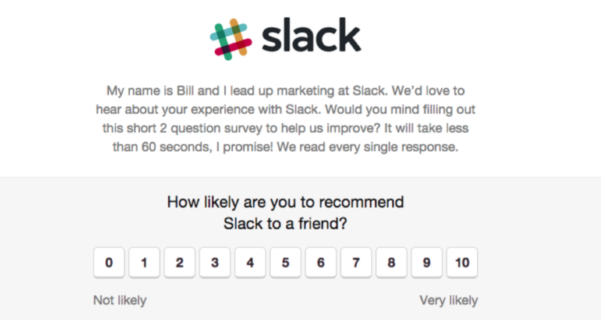
Slack not only aimed for positive feedback, but they also worked hard on turning every single user into a promoter. By doing this, together with fast and quality, positive word-of-mouth marketing, Slack has achieved its amazing results.
We talked with Bill Macaitis, the man behind Slack’s NPS. Find 7 new tips from Bill for your NPS survey here.
Mention
Mention App was proud to share that with the help of NPS they managed cut churn by half in only 2 months. In addition, they have been individually following up with every promoter, passive, and detractor.
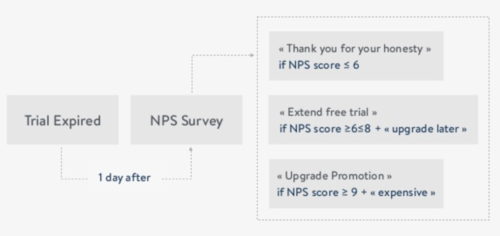
The full process is described in this presentation.
Promoters were offered a discount, passives received an extended free trial, and detractors were thanked and asked how things could be improved. Their recipe for a successful NPS campaign is facilitated automation, top answer rates, and qualitative handling.
Airbnb
Airbnb completed research on “How well does NPS predict rebooking?”. The results were quite interesting, they found that customers with an NPS score of 10 were 13% more likely to rebook and 4% more likely to refer a friend than detractors.
Net Promoter Score Benchmarks
Although the subtitle says “benchmark”, don’t rush into comparing your scores with top-performing companies. Let’s find your targets step-by-step. Although I have repeatedly noted that you should never chase the NPS number, I don’t mean that you shouldn’t think about it at all. The Net Promoter Score is a great way to follow trends, and check up on how you’re doing, and the “why” question helps you to understand the drivers behind the trends.
So, how to take control of your Net Promoter Score?
1. Make sure your Net Promoter Score is positive
Having NPS > 0 is already a reason to celebrate. That literally means you have more promoters than detractors and that’s a good thing.
2. Aim higher every month/quarter
Compare your current NPS to your past NPS. Is it higher? You’re doing a great job. Is it lower? Find out why and how you can make it better next time. Building quality relationships with your customers is your business, make sure you get it right.
3. Now you can check the industry and regional standards.
Ideally, you should search for companies in the same industry and in the same region. Comparing your results across regions or industries might be a close-to-impossible thing to do, as the standards vary a lot.
For example, the US scores have been always higher than European scores because of the culture and mentality. If you want to compare European and American NPS scores across the same industry, CheckMarket suggests counting 8 as a promoter score and 6 as a passive in Europe. The scores in Australia are typically even lower because of higher consumer expectations.
To learn more about NPS benchmarks, check out this article:
What is a good Net Promoter Score? – NPS benchmarks
Now that you know what score your company should aim for, let’s take a look at the top-performing companies from around the world.
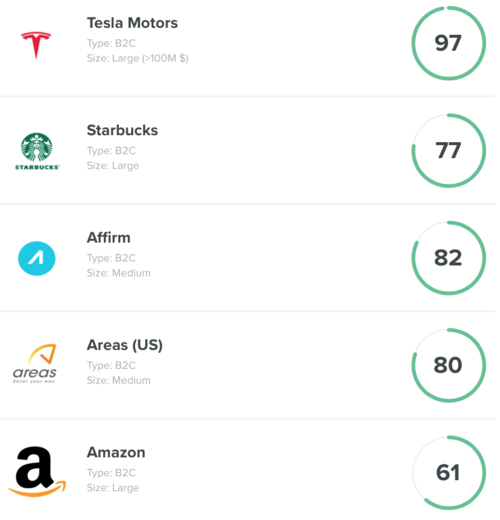
Top performing companies in March 2018 according to NPS Benchmarks
Although the Tesla score of 97 seems to be unrealistic (yes high scores are a standard among electric automobile industry), the score of Amazon has been improved along the way. In another very interesting piece of research, Amazon was chosen as the most trusted brand among SMB vendors (there’re also quite a few surprising industry benchmarks in the same research).
To sum it up, the main idea is to benchmark NPS against your own past performance in the first instance, and then try to find trustworthy and relevant NPS benchmarks in your industry and your region.
